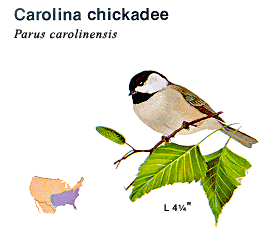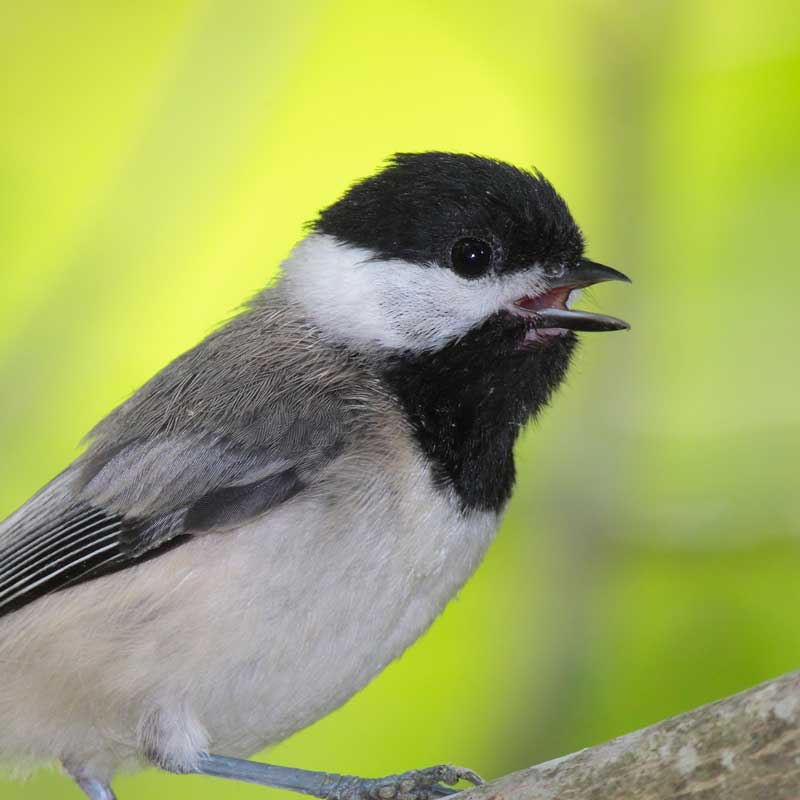RiskVA
Flighty, Flitty Carolina Chickadees 20 Jan 2004
Most people with backyard bird feeders, or much experience in the woods, are familiar with chickadees. These plump, darty, hyperactive little birds are year-round residents from southern Kansas, central Illinois, central Ohio, and central New Jersey south to central and southeastern Texas, the Gulf Coast and northern Florida. Only about 4 ½ inches long, these gray avians are recognized by their black cap, bib, and white cheeks.
In East Texas, many people refer to them as black-capped chickadees, which are not found here. Related to the titmouse and about the same size, Carolina chickadees are always on the move, dashing frantically from place to place in search of a bite to eat. In the winter they often travel in small flocks. Generally, they alight only briefly on a feeder, snatching a seed and flitting away to eat it in privacy. Their normal food includes seeds, both hard-coat and fleshy, small insects, and spiders gleaned from the bark of trees. At feeders, they like suet and sunflower seeds. The latter they hold with their feet and carefully split out the inner kernel with their beak. If you want to see how limber you are, try that with your food. Hold a peanut on the floor with your big toe, bend over, grasp it with your teeth, shell it, and chew well before swallowing. Or not.
Chickadees are acrobatic in their food gathering, often hanging upside down to eat. Their call sounds like their name: “chick-a-dee-dee-dee” and their song is a repeated "fee-bee fee-gay dee-dee-dee.” If you want to hear what they sound like, go to allaboutbirds.org, sponsored by The Cornell Lab of Ornithology. That site contains a wealth of information on all species of birds.
Chickadees nest in tree cavities in the wild. They may use preexisting holes or hollow out their own. Their nest usually has a base of moss and is filled with grass, fluffy plant materials, and feathers. Around our yard, they often try to take over our bluebird boxes. I try to evict them before they can really get started furnishing their purloined home, and they don’t like it. Perching in a nearby tree, the aspiring intruder chirps, chips, hisses, and buzzes angrily, and if I don’t repeat the de-nesting process several times, they’ll move back in spite of my efforts. Once they establish a nest site, they get downright cantankerous, diving and swooping at me. If they had wing-mounted machine guns, I’d be a dead duck.
Carolina chickadees take only one mate and remain together for years – sometimes permanently. They take turns defending their territory. Eggs are layed one a day, usually for a total of six, but the clutch size can vary from 5-8. The eggs are white with reddish-brown spots.
About two weeks after the last egg is layed, they begin to hatch. The female is the nest sitter and her mate brings food. Shortly after the eggs hatch, he becomes the food provider for both her and the nestlings. The young are able to fly within about two and a half weeks, but may hang around the nest accepting food from their parents for up to a month.
If you plan to feed chickadees, or any other birds, in your backyard, be sure you maintain the feeder regularly. Birds have a very high metabolism, requiring a lot of food to stay warm and healthy. They develop a mental map of food sources in the area and become dependent on feeders when they are available. If you suddenly stop feeding them, their lives may be in jeopardy unless they can quickly find substitute feeding locations.
Chickadees become very accustomed to the presence of people and will sit impatiently in a nearby tree, chirping anxiously as you refill their feeder.
Enjoy this spirited little visitor this winter. Chickadees are just one more part of nature’s variety in Texas fields and forests.
Dr. Risk is a professor emeritus in the College of Forestry and Agriculture at Stephen F. Austin State University in Nacogdoches, Texas. Content © Paul H. Risk, Ph.D. All rights reserved, except where otherwise noted. Click paulrisk2@gmail.com to send questions, comments, or request permission for use.


